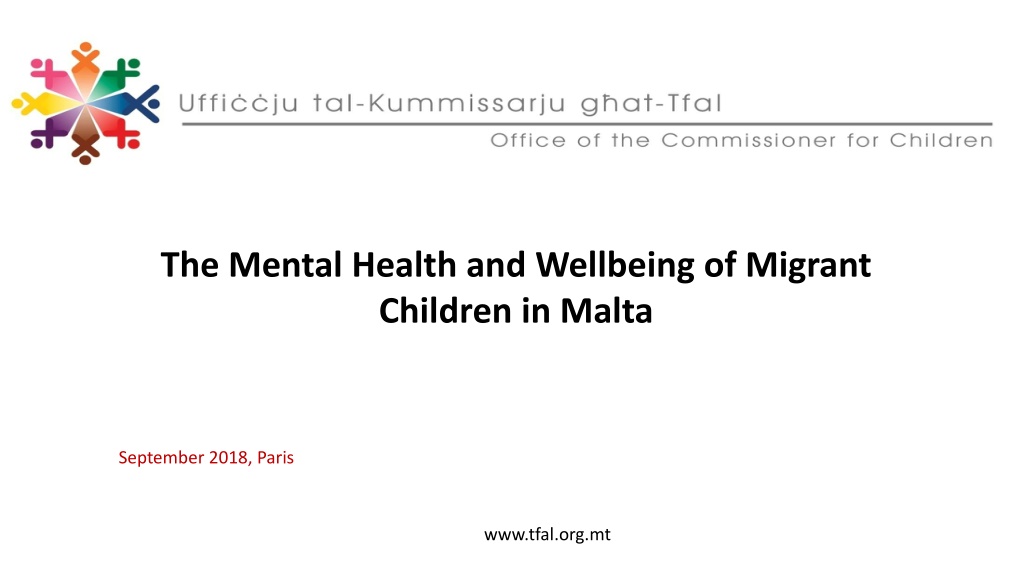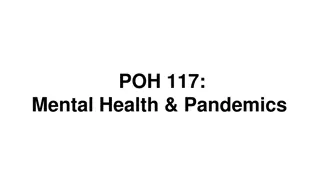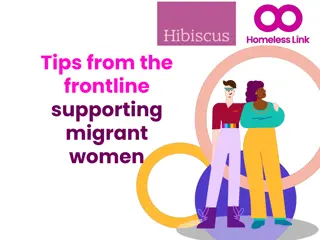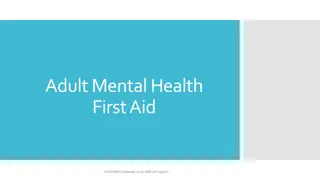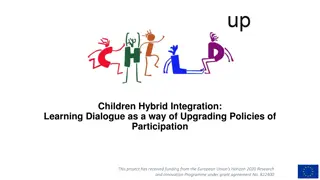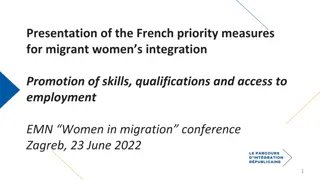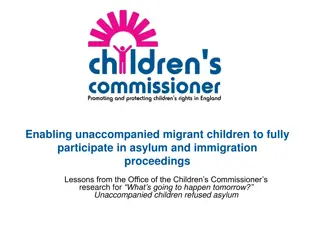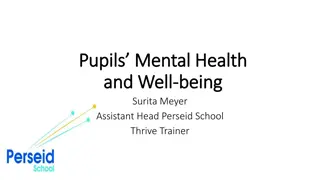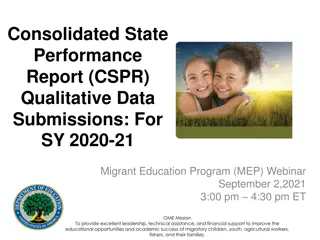Understanding the Mental Health of Migrant Children in Malta
The study conducted by the Office of the Commissioner for Children in Malta focuses on the mental health and wellbeing of migrant children and young people in the country. It aims to identify their needs, recommend ways to address them, and explore factors affecting their mental health, wellbeing, and inclusion. The study also sheds light on the challenges migrant children face, such as linguistic and cultural barriers, lack of access to services, and mental health risks. Through this research, efforts are made to create more supportive and inclusive environments for migrant children in Malta.
Download Presentation

Please find below an Image/Link to download the presentation.
The content on the website is provided AS IS for your information and personal use only. It may not be sold, licensed, or shared on other websites without obtaining consent from the author. Download presentation by click this link. If you encounter any issues during the download, it is possible that the publisher has removed the file from their server.
E N D
Presentation Transcript
The Mental Health and Wellbeing of Migrant Children in Malta September 2018, Paris www.tfal.org.mt
In 2016 , Office of the Commissioner for Children approached the Centre for Resilience and Socio-Emotional Health within the University of Malta. it was decided to carry out a research study to identify the needs of foreign children and young people living in Malta. Consequently the study will put forward a set of recommendations how the needs of migrant children should be adequately addressed. Even though there are a few small scale studies on various aspects of the development of migrant children in Malta there is no comprehensive study examining the wellbeing, resilience, inclusion and education of such children.
Trends in Malta In 2017 the population in Malta increased by +33 per 1000 residents, more than 15 times the rate in the EU (+2.1), bringing the population up to 475,700 Migration has become the main driver pushing up Malta's population: the number of non-Maltese living in Malta has more than doubled over the last decade. 2017: 43,000 foreign workers in Malta: 30,564 EU nationals, 12,407 third country nationals (7,748 Italians 4,819 Britons and 2,439 Bulgarians; 2,413 Filipinos, 2,329 Serbs).
Non EU nationals In 2018 there were 27,238 non-EU foreign nationals registered in Malta. The ten countries with the most nationals registered to live in Malta: 1. Libya 3,622 2. Serbia 2,757 3. The Philippines 2,407 4. Russia 2,027 5. Somalia 1,845 6. Syria 1,289 7. China 1,090 8. Eritrea 1,057 9. Ukraine - 896 10. India 819
Migrant Children One of the main issues of this movement of people, both from the north and from the south, is the welfare of children and young people who in many instances have little say in what his happening in their lives in such circumstances. Children living in a different country may face a number of challenges in their education, wellbeing and mental health, including linguistic and cultural barriers, lack of access to educational, psychological, social and medical services, and difficulties in social inclusion amongst others. They may be also at heightened risk for certain mental health problems, including post-traumatic stress, depression and anxiety, particularly if not provided with adequate and timely support.
Objectives of the study The study aims to determine: The level of health, wellbeing and resilience of migrant children in Malta, and how this may vary by individual and contextual factors. The factors related to positive mental health, wellbeing and resilience. Inclusion in schools and within the community and what may hinder it. Access to services. Children s views on their own wellbeing. What may help to create more accessible, inclusive and resilience- enhancing spaces for migrant children.
Approach The Study takes a resilience perspective. The Study also children s subjective wellbeing, seeking to listen to children s own voices about their wellbeing, health, inclusion and resilience. Study makes use of both quantitative and qualitative methods
Methodology Participants - children under the age of 18 who are either born outside Malta or in Malta to non-Maltese parents. All overseas children in Malta (and their teachers and parents/carers) who could be identified through schools, homes, centres and agencies, were invited to participate.
The study has been designed in 5 major parts: Part 1: Data collection with school age children (Kindergarten - Form 5): students, parents and teachers in State, Church & Independent Schools and Open Centres. Part 2: Data collection from students at post-secondary level. Part 3: Data collection from carers and parents of children attending Childcare Centres. Phase 4: Focus groups with primary and secondary migrant children currently attending state schools. Phase 5 : Data Collection from Maltese students on their attitudes towards migrant children
Highest student population of overseas students by school sector and nationality (2016/17) State Schools (primary and secondary) 98 nationalities and 24 mixed nationalities Highest student populations (descending order): UK, Italy, Libya, Bulgaria, Syria Church schools (primary and secondary) 29 nationalities; highest student populations (descending order): UK, Italy, Serbia, Bulgaria, China, USA Independent Schools (primary and secondary) 74 nationalities and 25 mixed nationalities Highest student populations (descending order): Libya, UK, Italy, Russia, Sweden
Instruments Student Questionnaires Subjective wellbeing Questionnaire (Primary & Secondary versions) (Rees & Main, 2015) Child and Youth Resilience Measure (Child & Youth versions) (CYRM-28, CRC, 2013) Strengths and Difficulties Questionnaire (Secondary) (SDQ, Goodman, 1997) Parent Questionnaires: Access to Services Questionnaire Child Health Questionnaire Strengths and Difficulties Questionnaire (SDQ, Goodman, 1997) Teacher Questionnaires: Educational engagement questionnaire Strengths and Difficulties Questionnaire (SDQ, Goodman, 1997)
Living in Malta: Adults care about children
Adults care about children by age Note: student t-test p>0.05
Living in Malta: Malta is a safe place for children to live
Malta is a safe place for children to live by age Note: student t-test p>0.01
Economic well-being: How satisfied with the things you have? (Primary students)
How satisfied with the things you have? (Secondary students)
Home: How satisfied with the home you live in? (primary students)
Home: How satisfied with the home you live in? (secondary students)
In my area there are enough places to play and have a good time
Preliminary Findings 2/3 of migrant children living in Malta are Europeans (Western and Eastern) 2/3 of the children attend state schools and there are more difficulties in state schools SDQ scores cut off points well within the average or below, while the resilience scores quite high, suggesting a portrait of healthy, resilient children on the whole
Preliminary Findings The subjective wellbeing questionnaire (voice of the children) presents a positive picture on the whole but underlines difficulties for about 15% of the children in various aspects of their lives (eg bullying, friends, locality) as well as for particular groups (eg economic wellbeing, enough food). The findings still need to be analysed further for differences by gender, age, school, ethnicity. The full report should be launched by the end of 2018.
Thank You Email: pauline.miceli@gov.mt Website: www.tfal.org.mt
